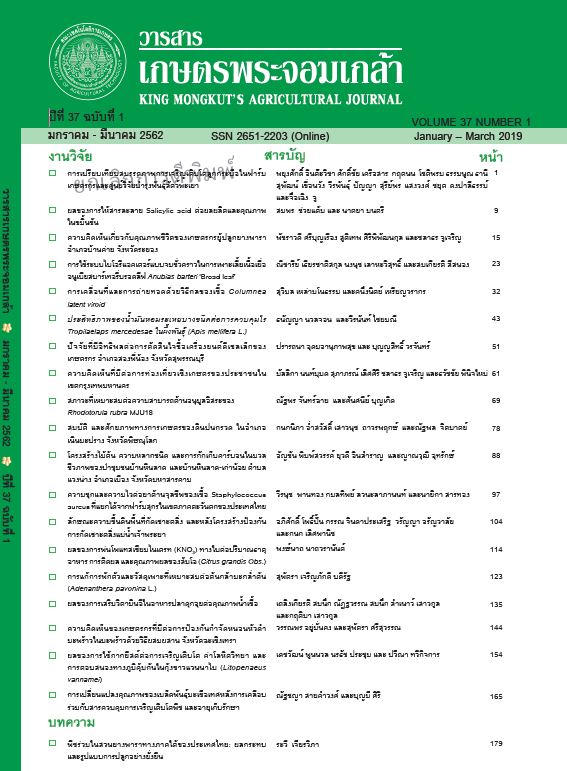ประสิทธิภาพของน้ำมันหอมระเหยบางชนิดต่อการควบคุมไร Tropilaelaps mercedesae ในผึ้งพันธุ์ (Apis mellifera L.)
Main Article Content
บทคัดย่อ
ไร Tropilaelaps เป็นศัตรูผึ้งที่มีการแพร่ระบาดในอุตสาหกรรมการเลี้ยงผึ้งพันธุ์ (Apis mellifera L.) ใน ทวีป
เอเชีย โดยไรชนิดนี้สามารถทำลายตัวอ่อนผึ้ง ทำให้ตัวอ่อนผึ้งตายและอาจส่งผลให้รังผึ้งร้างในที่สุด ซึ่งงาน วิจัยนี้
เป็นการทดสอบประสิทธิภาพของน้ำมันหอมระเหยจากพืชจำนวน 4 ชนิด คือ ข่า (Alpinia galanga) ขมิ้นชัน
(Curcuma longa L.) ชมพู่ (Syzygium sp.) และขิง (Zingiber officinale R.) ต่อการฆ่าไรและผึ้งระยะตัวเต็มวัยโดย
วิธี vapor exposure method จากผลการทดลอง พบว่า น้ำมันหอมระเหยจากขมิ้นชันมีประสิทธิภาพ ในการฆ่าไร
Tropilaelaps mercedesae ได้ดีที่สุด โดยในชั่วโมงที่ 4 หลังการทดสอบ มีค่า LC50 เท่ากับ 0.06% (v/v) รองลงมาคือ
น้ำมันหอมระเหยจากขิง ข่า และชมพู่ ซึ่งมีค่า LC50 เท่ากับ 0.14%, 0.24% และ 0.40% (v/v) ตามลำดับ นอกจากนี้
ยังพบว่า น้ำมันหอมระเหยจากพืชทั้ง 4 ชนิด สามารถฆ่าไร T. mercedesae ได้ 100% ในชั่วโมงที่ 24 หลังการทดสอบ
ที่ระดับความเข้มข้นที่ใช้ทดสอบ เมื่อนำน้ำมันหอมระเหยทั้ง 4 ชนิดไปทดสอบกับ ผึ้งในระยะตัวเต็มวัย พบว่า น้ำมัน
หอมระเหยจากข่า ขมิ้นชัน ชมพู่ และขิงไม่มีความเป็นพิษต่อตัวผึ้ง โดยมีค่า LC50 มากกว่า 10% (v/v) ในชั่วโมงที่ 4,
24, 48 และ 72 ของการทดลอง อย่างไรก็ตามควรที่จะทำการทดสอบ ประสิทธิภาพของน้ำมันหอมระเหยในระดับ
รังผึ้งซึ่งเป็นสภาวะจริงก่อนนำไปใช้จริง
Article Details
วารสารเกษตรพระจอมเกล้า
References
Formicomotes heteromorphus Magowski โดยใช้น้ำมันหอมระเหยจากพืช. รายงานฉบับสมบูรณ์โครงการวิจัย เงินงบประมาณ
ปี 2551. คณะเทคโนโลยีการเกษตร. สถาบันเทคโนโลยีพระจอม เกล้าเจ้าคุณทหารลาดกระบัง กรุงเทพฯ.
จรงค์ศักดิ์ พุมนวน พิฆเนศ รองพล และอำมร อินทร์สังข์. 2553. ประสิทธิภาพของน้ำมันหอมระเหยจากพืชสมุน ไพรในการฆ่าไรดีด
Formicomotes heteromorphus Magowski โดยวิธีการสัมผัส. วารสารวิทยาศาสตร์ มข. 38: 124–132.
อ?ำมร อินทร์สังข์ และจรงค์ศักดิ์ พุมนวน. 2552. ผลของน้ำมันหอมระเหยจากพืชต่อไรฝุ่น Dermatophagoides pteronyssinus
(Trouessart). วารสารวิทยาศาสตร์ มข. 37: 183–191.
อัจจิมา นุชโพธิ์ จรงค์ศักดิ์ พุมนวน และอำมร อินทร์สังข์. 2557. ประสิทธิภาพของน้ำมันหอมระเหยจากขมิ้นชัน (Curcuma longa) ไพล
(Zingiber cassumunas) และข่า (Alpinia galanga) ในการควบคุมไรเชื้อรา (Tyrophagus sp.) โดยวิธีการรมและ วิธีการสัมผัส.
วารสารเกษตรพระจอมเกล้า 32: 1–7.
Anderson, D.L. and M.J. Morgan. 2007. Genetic and morphological variation of bee-parasitic Tropilaelaps mites (Acari:
Laelapidae): new and re-defined species. Exp. Appl. Acarol. 43: 1–24.
Atwal, A.A. and N.P. Goyal. 1971. Infestation of honeybee colonies with Tropilaelaps, and its control.
J. Apic. Res. 10: 137–142.
Burgett, M., P. Akratanakul and R.A. Morse. 1983. Tropilaelaps clareae: a parasite of honeybees in south-east Asia. Bee
World 64: 25–28.
Chen, Y.P. and J.D. Evans. 2007. Historical presence of Israeli acute paralysis virus in the United States. Am. Bee J. 147:
1027–1028.
Dainat, B., T. Ken, H. Berthoud and P. Neumann. 2009. The ectoparasitic mite Tropilaelaps mercedesae (Acari, Laelapidae)
as a vector of honeybee viruses. Insectes Soc. 56: 40–43.
Damalas, C.A. 2011. Potential uses of turmeric (Curcuma longa) products as alternative means of pest management in crop
production. Plant Omics 4: 136–141.
De Jong, D., R.A. Morse and G.C. Eickwort. 1982. Mite pests of honeybees. Annu. Rev. Entomol. 27: 229–252.
Delfinado-Baker, M.D. and E.W. Baker. 1982. A new species of Tropilaelaps parasitic on honeybees. Am. Bee J. 122:
416–417.
Devkota, L. and M. Rajbhandari. 2015. Composition of essential oils in turmeric rhizome. Nepal J. Sci. Technol. 16: 87–94.
Forsgren, E., J.R. de Miranda, M. saksson, S. Wei and I. Fries. 2009. Deformed wing virus associated with Tropilaelaps
mercedesae infesting European honeybees (Apis mellifera). Exp. Appl. Acarol. 47: 87–97.
Higes, M., R. Martín and A. Meana. 2006. Nosema ceranae, a new microsporidian parasite in honeybees in Europe. J.
Invertebr. Pathol. 92: 93–95.
Jayaprakasha, G.K., P.S. Negi, C. Anandharamakrishnan and K.K. Sakariah. 2001. Chemical composition of turmeric oil - a
byproduct from turmeric oleoresin industry and its inhibitory activity against different fungi. Z. Naturforsch. C. 56:
40–44.
Khongphinitbunjong, K., L.I. de Guzman, M.D. Burgett, T.E. Rinderer and P. Chantawannakul. 2012. Behavioural responses
underpinning resistance and susceptibility of honeybees to Tropilaelaps mercedesae. Apidologie 43: 590–599.
Kitprasert, C. 1984. Biology and systematics of the parasitic bee mite, Tropilaelaps clareae Delfinado and Baker
(Acarina: Laelapidae). M.S. Thesis, Kasetsart University, Bangkok, Thailand.
Klee, J., A.M. Besana, E. Genersch, S. Gisder, A. Nanetti, D.Q. Tam, T.X. Chinh, F. Puerta, J.M. Ruz,
P. Kryger, D. Message, F. Hatjina, S. Korpela, I. Fries and R.J. Paxton. 2007. Widespread dispersal of the
microsporidian Nosema ceranae, an emergent pathogen of the western honeybee, Apis mellifera. J. Invertebr. Pathol.
96: 1–10.
Laigo, F.M. and R.A. Morse. 1969. Control of the bee mites Varroa jacobsoni Oudemans and Tropilaelaps clareae
Delfinado and Baker with chlorobenzilate. Philippine Entomologist 1: 144–148.
Morse, R.A. and N.W. Calderone. 2000. The value of honeybees as pollinators of U.S. crops in 2000.
Bee Culture 128: 1–15.
Pumnuan, J. and A. Insung. 2012. Effectiveness of essential oils of medicinal plants against stored product mite, Suidasia
pontifica Oudemans. Acta Hortic. 945: 79–85.
Ritter, W. 1988. Varroa jacobsoni in Europe, the tropics, and subtropics, pp. 349-359. In G.R. Needham, R.E. Page, M.
Delfinado-Baker and C.E. Bowman, eds. Africanized Honey bees and Bee Mites. Ellis Horwood, Chichester.
Ruffinengo, S., M. Eguaras, I. Floris, C. Faverin, P. Bailac and M. Ponzi. 2005. LD50 and repellent effects of essential oils from
argentinian wild plant species on Varroa destructor. J. Econ. Entomol. 98: 651–655.
Tangjingjai, W., P. Verakalasa, S. Sittipraneed, S. Klinbunga and C. Lekprayoon. 2003. Genetic differences between
Tropilaelaps clareae and Tropilaelaps koenigerum in Thailand based on ITS and RAPD analyses. Apidologie 34:
513–524.
Tavares, W.D.S., S.D.S. Freitas, G.H. Grazziotti, L.M.L. Perente, L.M. Liäo, and J.C. Zanuncio. 2013.
Ar-turmerone from Curcuma longa (Zingiberaceae) rhizomes and effects on Sitophilus zeamais (Coleoptera:
Curculionidae) and Spodoptera frugiperda (Lepidoptera: Noctuidae). Ind. Crops Prod. 46: 158–164.
Underwood, B.A. 1986. The natural history of Apis laboriosa Smith in Nepal. M.S. Thesis, Cornell University, Ithaca, NY.
Woyke, J. 1985a. Tropilaelaps clareae, a serious pest of Apis mellifera in the tropics, but not dangerous for apiculture in
temperate zones. Am. Bee J. 125: 497–499.
Woyke, J. 1985b. Further investigation into control of the parasitic bee mite Tropilaelaps clareae without medication. J. Apic.
Res. 24: 250–254.

